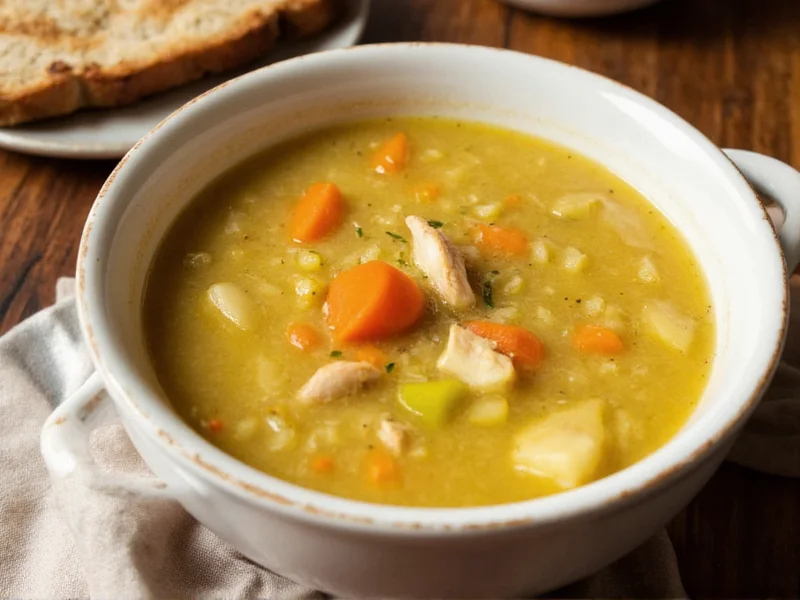Understanding the calorie content of chicken soup is essential for anyone monitoring their dietary intake, whether for weight management, health conditions, or general wellness. This comprehensive guide examines the nutritional profile of various chicken soup preparations, helping you make informed choices that align with your dietary goals.
Factors That Influence Chicken Soup Calorie Count
The calorie content in chicken soup varies significantly based on multiple factors. Unlike standardized packaged foods, chicken soup recipes differ widely across households, brands, and restaurants, creating a broad calorie spectrum. The primary variables affecting calories include:
- Chicken preparation method - Skinless breast meat yields fewer calories than thigh meat with skin
- Fat content - Skimming fat from broth reduces calories substantially
- Added ingredients - Noodles, rice, cream, or butter significantly increase calorie density
- Serving size - Restaurant portions often exceed standard 1-cup measurements
- Broth concentration - Reduced-sodium versions sometimes contain more solids per volume
Calorie Comparison Across Chicken Soup Varieties
Below is a detailed comparison of calorie content across different chicken soup types. These values represent standard 1-cup (8-ounce) servings unless otherwise noted:
| Soup Type | Calories per Cup | Protein (g) | Fat (g) | Carbohydrates (g) |
|---|---|---|---|---|
| Homemade (clear broth, minimal chicken) | 60-80 | 6-8 | 2-3 | 3-5 |
| Homemade (with vegetables and noodles) | 90-120 | 7-9 | 3-4 | 10-15 |
| Canned regular chicken noodle soup | 100-130 | 5-7 | 3-5 | 12-16 |
| Canned low-sodium chicken soup | 60-85 | 5-6 | 1-2 | 8-12 |
| Creamy chicken soup (canned) | 180-250 | 6-8 | 10-15 | 15-20 |
| Restaurant chicken matzo ball soup | 150-220 | 8-10 | 6-9 | 15-20 |
| Restaurant creamy chicken soup | 250-400+ | 10-15 | 15-25 | 15-25 |
Nutritional Profile Beyond Calories
When evaluating chicken soup nutrition, calories represent just one component of the complete nutritional picture. The protein content in chicken soup typically ranges from 5-15 grams per serving, making it a valuable source of this essential macronutrient. Sodium levels vary dramatically:
- Homemade versions: 300-600mg per cup
- Standard canned soups: 700-900mg per cup
- Restaurant servings: 800-1,500mg per cup
The vegetable content in well-prepared chicken soup provides vitamins A and C, potassium, and other micronutrients. Clear broths offer hydration benefits while being relatively low in calories, making them suitable for various dietary approaches including intermittent fasting protocols when consumed during eating windows.
Chicken Soup in Different Dietary Approaches
Chicken soup's versatility allows it to fit into numerous dietary frameworks when prepared appropriately. For those following weight loss plans, broth-based versions with ample vegetables and lean chicken provide volume and nutrients with minimal calories. The high water content and moderate protein create satiety while keeping energy intake moderate.
Individuals managing diabetes should pay particular attention to carbohydrate content, especially when noodles or rice are included. Opting for vegetable-heavy versions without starchy additions creates a lower-glycemic option that fits well within blood sugar management plans.
During illness recovery, the calorie density of chicken soup becomes beneficial. The easily digestible protein and electrolytes support healing, while the warmth and liquid content aid hydration—particularly valuable when appetite is diminished.
Creating Lower-Calorie Chicken Soup at Home
Producing a satisfying yet lower-calorie chicken soup requires strategic ingredient choices and preparation techniques. Start with skinless chicken breast rather than thigh meat to reduce fat content. Simmer the broth thoroughly, then chill it to easily remove solidified fat from the surface—a step that can reduce calories by 20-30%.
Maximize volume and nutrition without adding significant calories by incorporating:
- Zucchini noodles instead of traditional pasta
- Extra carrots, celery, and onions for natural sweetness
- Leafy greens like spinach or kale added at the end
- Herbs and spices for flavor without calories
For creamy texture without heavy cream, blend cooked cauliflower into the broth. This technique maintains the comforting mouthfeel while keeping calories in check—ideal for those searching for low calorie creamy chicken soup alternatives.
Common Misconceptions About Chicken Soup Calories
Several myths persist about chicken soup and its nutritional value. Many believe all chicken soup is inherently low calorie, but restaurant versions and creamy preparations can rival main course calorie counts. Another misconception suggests chicken soup lacks nutritional value, when in reality, properly prepared versions offer protein, hydration, and micronutrients.
The notion that chicken soup boosts metabolism significantly is overstated—while the thermic effect of food exists, the impact is minimal. However, chicken soup's high water content and moderate protein do support satiety, which can indirectly aid weight management efforts when incorporated into balanced meal plans.
Reading Nutrition Labels for Canned Chicken Soup
When purchasing canned varieties, understanding nutrition labels prevents unexpected calorie intake. Pay attention to serving size—many cans contain multiple servings despite appearing single-serve. The ingredient list reveals whether the soup contains hidden calorie sources like cream, butter, or excessive oil.
Compare sodium content across brands, as lower-sodium versions often maintain flavor through herbs rather than salt. Some 'light' labeled soups compensate for reduced fat with added carbohydrates, so checking the complete nutritional profile is essential for those tracking chicken noodle soup carbohydrate content specifically.











 浙公网安备
33010002000092号
浙公网安备
33010002000092号 浙B2-20120091-4
浙B2-20120091-4